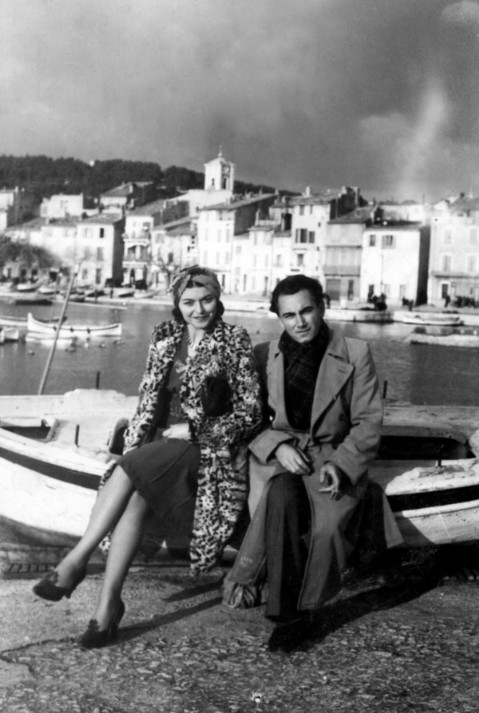ODETTE CAMP (1909-1979)
Notice biographique, par Michel Solis
Odette Camp was born in Marseille on 19 March, 1909. Her Protestant parents, Victor Camp and Lucile Guilhon, moved to Paris in 1912. She loved the capital and chose to spend nearly all of her life there. After attending secondary school as a boarder at the Lycée Victor Duruy, during four years she studied at the Ecole Nationale des Arts Décoratifs and the Ecole Nationale des Beaux-Arts, as well as at the atelier of artist Jean Despujols.
In 1928, she married the young winner of music’s Grand Prix de Rome, Henri Tomasi. She was the composer-conductor’s most faithful associate; until his death separated them on 13 January 1971, her days were divided between his world of music and her art. While her primary focus was the vocation of the composer in her life, from 1930 on she regularly exhibited her own work.
Her earliest pieces were paintings shown under the pseudonym Otomasi. Her oils, rendered with the painter’s knife, were very colorful and descriptive images inspired by southern subjects such as Provence and Corsica. Her work was regularly exhibited at the Salon d’Automne, the Société des Amis du Louvre, the Indépendants, the Société Nationale des Beaux-Arts... and several of her paintings were purchased by the state and the city of Marseille, as well as by certain stars, including Jean Gabin. Before WWII, she had regular shows at La Galerie Carmine, Rue de Seine in Paris, along with artists belonging to the Ecole de Paris who have since become famous: Brayer, Douking, Othon Friesz, and Poliakoff. Her first one-woman show took place in Marseille in February 1942 at the Galerie Saint Fé.
In 1947, she reclaimed her original name, Odette Camp. This greater personal affirmation went hand in hand with a change in style - more freedom, less scholasticism - and a change in subject matter and ambience. Her paintings of this period centered on Paris and Brittany, in misty gray and marine tones reminiscent of Marquet. During this period, which lasted until 1955, in addition to designing the set of her husband’s opera L’Atlantide (in Vichy, then Lyon), she held several personal exhibitions in Paris which were very well received: Galerie Barbedienne, Avenue F. Roosevelt (1949), Galerie Serret, Rue du Faubourg St-Honoré (1952), Galerie Cazelles (1954), also Rue du Faubourg St-Honoré.
When a friend commented that her drawing ‘could be more sophisticated’, Odette Camp took it as a challenge. In 1958 a new show at the Galerie Michel, Quai St-Michel in Paris, featured as many sketches as paintings. From then on, her vocation as an artist revolved around her talent for illustration and drawing. The Galerie Motte, both in Paris in 1960 and in Geneva in 1966, established Camp as a master of India ink techniques and a precious witness of ‘Old Paris’. The author Thyde Monnier wrote a fine piece about her work at the time. Other subjects - Venice, Ibiza - were also portrayed in India ink, highlighted with the subtle colors of gouache.
Her art was to become darker with the years, her sketches of Paris relieved of any human presence, and her fascination with leafless trees, trunks, and roots would give rise to powerful, disturbing, and atypical forms. In 1962 and 1967, her work was present in group exhibitions at the Galerie Marcel Bernheim, Rue La Boétie. She also continued to participate in many venues such as the Société de l’Ecole Française (1961), Terres Latines (1962 to 1966), Le Club International Féminin (1965), Salon du Dessin et de la Peinture à l’eau (The Drawing and Watercolor Show, from 1965 to 1972), Comparaisons (1976). Again, several of her pieces were purchased by the state and the city of Paris. During her lifetime, her last two exhibitions were held in Café Procope (1975), and Cimaises Ventadour, one year before her demise on 4 August 1979 in her dearly beloved city: Paris.
Naturally, then, it was in the capital that two important Camp retrospectives were held. In 1981, the first, at the Galerie Hérouet, Rue des Francs-Bourgeois, presented the full collection of her graphic art. The second, ‘Paris disparu’, was held in 1983 at the Musée Carnavalet to mark the donation of a collection of forty sketches. A text by Carnavalet’s head curator, Bernard de Montgolfier, an article by Olivier Schmitt in Le Monde (24-07-1983), and another by Edmée Santy in Le Provençal (24-08-1983) all confirm that Odette Camp was, without a doubt, an entirely authentic artist. Far from trends and fashion, her timeless art makes her a singular and genial member of the Ecole de Paris.
2009, the hundred-year anniversary of Odette Camp’s birth, and thirtieth anniversary of her departure, gives us the perfect opportunity to rediscover the full scope and depth of this innovative artist’s admirable talent.


